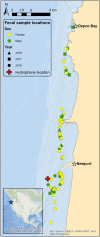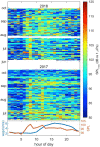Effects of vessel traffic and ocean noise on gray whale stress hormones
- PMID: 36329054
- PMCID: PMC9633705
- DOI: 10.1038/s41598-022-14510-5
Effects of vessel traffic and ocean noise on gray whale stress hormones
Abstract
Human use of marinescapes is rapidly increasing, especially in populated nearshore regions where recreational vessel traffic can be dense. Marine animals can have a physiological response to such elevated human activity that can impact individual health and population dynamics. To understand the physiological impacts of vessel traffic on baleen whales, we investigated the adrenal stress response of gray whales (Eschrichtius robustus) to variable vessel traffic levels through an assessment of fecal glucocorticoid metabolite (fGC) concentrations. This analysis was conducted at the individual level, at multiple temporal scales (1-7 days), and accounted for factors that may confound fGC: sex, age, nutritional status, and reproductive state. Data were collected in Oregon, USA, from June to October of 2016-2018. Results indicate significant correlations between fGC, month, and vessel counts from the day prior to fecal sample collection. Furthermore, we show a significant positive correlation between vessel traffic and underwater ambient noise levels, which indicates that noise produced by vessel traffic may be a causal factor for the increased fGC. This study increases knowledge of gray whale physiological response to vessel traffic and may inform management decisions regarding regulations of vessel traffic activities and thresholds near critical whale habitats.
© 2022. The Author(s).
Conflict of interest statement
The authors declare no competing interests.
Figures





References
-
- McDonald MA, Hildebrand JA, Wiggins SM. Increases in deep ocean ambient noise in the Northeast Pacific west of San Nicolas Island, California. J. Acoust. Soc. Am. 2006;120:711–718. - PubMed
-
- Kaplan MB, Solomon S. A coming boom in commercial shipping? The potential for rapid growth of noise from commercial ships by 2030. Mar. Policy. 2016;73:119–121.
-
- McCarthy E. International regulation of underwater sound: establishing rules and standards to address ocean noise pollution. Kluwer Academic Publishers; 2004.
-
- Weilgart LS. The impacts of anthropogenic ocean noise on cetaceans and implications for management. Can. J. Zool. 2007;85:1091–1116.
-
- Bas AA, et al. Marine vessels alter the behaviour of bottlenose dolphins Tursiops truncatus in the Istanbul Strait, Turkey. Endanger. Species Res. 2017;34:1–14.
Publication types
MeSH terms
Substances
Grants and funding
LinkOut - more resources
Full Text Sources
Medical

